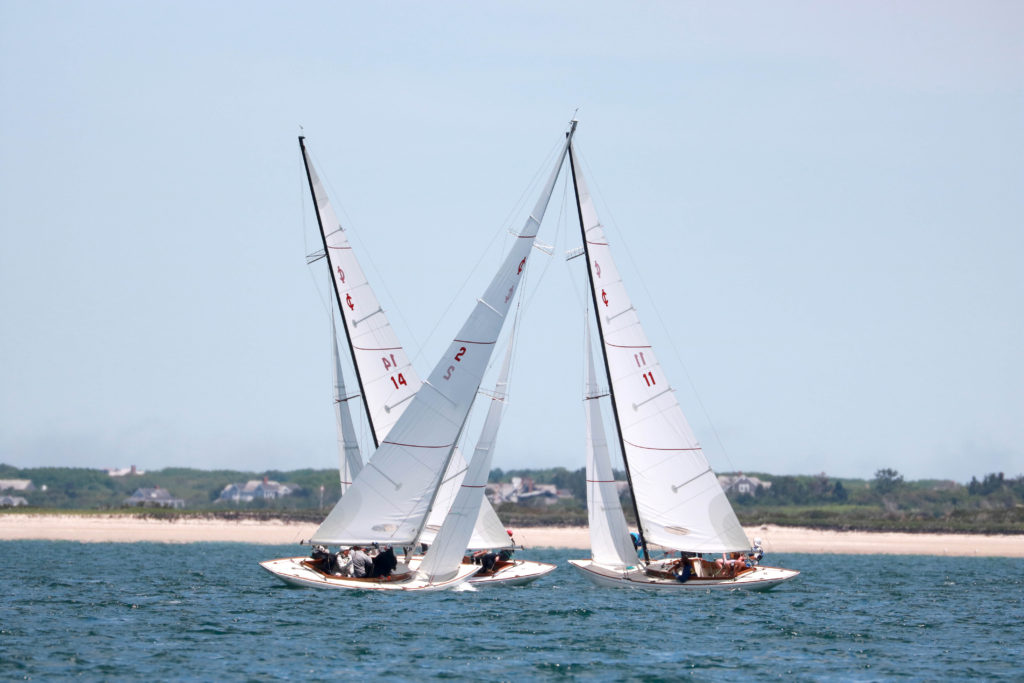How the Nantucket IOD Fleet Does It
By Chris Gould
Nantucket’s IOD fleet is unique in its ownership structure, but many issues related to sail purchase are common to other IOD fleets. Most IOD racing is truly local, so purchasing sails for the entire fleet at the same time, from a single sailmaker, makes sense in all respects. The sails should be identical, consistent with one-design principles, and volume discounts should significantly reduce costs.
Importantly, buying in batches means the sails will age similarly, assuming sails get roughly even usage. Everyone likes noisy new sails. But even when sails are showing their age, at least the competition is standardized. In Nantucket we aim to accomplish that objective by rotating boats. Although weather conditions and participation varies from week to week, the aging process tends to even out over the life of the sails. We can do so because all the boats are owned by an association (which in turn is owned by the sailors). In a conventional ownership model, fleets should consider sail rotation or other means to accomplish uniform wear and tear.
Background
The Nantucket IOD Fleet Association board of directors (representing a cross section of participating ownership “syndicates”) decides when to replace sails. The fleet races about 15 to 18 days per season, typically in moderate to windy conditions. We expect to see mainsails last six years, jibs about half as long – three or four years, and spinnakers four or five years. We usually try to stagger purchases in order to avoid spikes in the operating budget.
Sailmakers
Requests for proposals are sent in the fall, in order to place the order before winter. We expect, and receive, attractive discounts for quantity and off-season purchase.
For our most recent order, the RFP went to two sailmakers with whom we have worked successfully in the past. Both companies have been attentive and supportive of our local fleet and our local community sailing program. We deliberately seek multiple bids in order to derive benefits of competition – both economics and service. At the same time, limiting the solicitation to two, or possibly three respondents reinforces relationships over the long term.
We choose sailmakers who have demonstrated experience with IODs, on board and in sail design and construction. Logistics are important for delivery, winter maintenance and storage, as well as emergency repair.
Criteria
Bids are evaluated on merit. Price is an objective factor, but many considerations are subtle, subjective, and subject to debate. Performance in a wide range of conditions, handling characteristics, complexity of trim are examples of the latter.
We have to be convinced regarding uniformity. We ask that orders be prepared from the same batch of cloth. We evaluate sailmakers’ recommendations regarding cloth and construction. For example, we’ve tried both tri-radial design with warp-oriented cloth, and cross-cut with more conventional weave (fill) oriented threads. Both methods are satisfactory with the right cloth. In the most recent instance we concluded cost savings with the cross-cut outweighed the possible longevity edge of tri-radial. Hopefully we get a little smarter with each generation of sails. Balancing orders among or between sailmakers is a consideration; it’s more of a tiebreaker rather than a priority. And other things equal, some of our decision contributors would probably give the nod to local versus offshore manufacturing.
Devil in the Detail
Part of successful sail replacement is paying attention. Try to learn from past experience. Several years ago we received a batch of jibs with a too-generous girth measurement, and the leech fouled on the lower shroud when close hauled. The fleet went to the trouble and expense of relocating the shrouds, which in turn led to various other problems. We should have asked the sailmaker to modify the sails.
More recently, we learned just before our season opener that construction of new mains had not yet commenced, and the maker was backlogged. The old sails were already being made into beach bags. Amidst drama and angst, the sails arrived – 36 hours before the skippers meeting. Lessons: request status reports, and be a squeaky wheel when necessary.
Learn from mistakes, and provide feedback. We’ve had issues with window placement and window material – some plastic performs well at first but becomes dark and cloudy after a couple of years. Give feedback to the sailmakers.
Conclusion
It’s not rocket science, but neither can the process be taken for granted. Optimizing sail replacement is like every other aspect of sailing: experience, planning, execution, attention and luck! And like sailing, it’s all about the people you’re working with, whether crew or sailmakers.
A template of the RFP that Bobby Constable and I developed accompanies this piece, and can be found here.
Chris Gould has chaired the Nantucket IOD Fleet’s technical committee for several years. He is also chair or co-chair of the Nantucket Race Week IOD Celebrity Invitational since 2010. In 2018, he helmed the winning boat at the 2018 Nantucket Invitational sailing with an all-Bravo syndicate crew.

